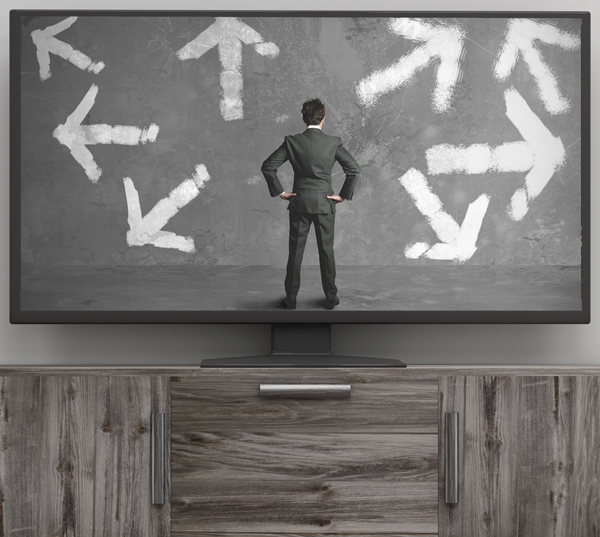So Many Choices, So Little Time
By Stewart Schley
How a Hybrid Approach to Video Delivery Aims to Solve Television’s Paradox of Plenty
About 12 years ago, a group of academic researchers began publishing some surprising findings around a little-studied subject: choice.
Their conclusion was two-fold. First, they recounted how there had never been so much choice available to everyday consumers. Grocery store shelves were lined with dozens of variations of jams, and that was just in the raspberry section. Denim jeans came in more sizes, colors, button styles and finishes than shoppers could imagine. A cup of coffee had morphed from a relatively simple conceit into a cascading menu of possibilities, from skinny lattes to tall Americanos to half-caf skims. Online dating sites dizzied romance-seekers with page after page of candidates, presenting more possible mates than a person in the pre-digital generation might ever come to know.
It was the companion finding that was more surprising. Rather than revel in this newfound wellspring of choice, people often shrank from it in trepidation and worry, overwhelmed by the sheer range of possibilities and stressed by an inner voice that fretted about the likelihood of ending up with an inferior selection. In the 2004 book The Paradox of Choice: Why More Is Less, author Barry Schwartz wrote that “Part of the downside of abundant choice is that each new option adds to the list of trade-offs, and trade-offs have psychological consequences.”

Which brings us to the modern consumer video ecosystem, where choice has exploded like in no other category. Netflix alone offers more than 20,000 discrete TV program episodes, and it’s just one of a growing array of subscription VOD services. Comcast says its X1 VOD platform now features more than 85,000 total choices. Hulu has 20,000 TV shows. YouTube contributors add hundreds of hours of new video every 60 seconds.
If a few dozen variations of blue jeans can send consumers reeling, it’s not a stretch to imagine the psychic carnage tied to a sprawling video category that has leapfrogged from the pre-determined (or “curated”) network schedules of yesteryear to something that resembles less of a traditional TV channel and more of a bookstore gone berserk, with tens of thousands of choices beckoning.
Jeff Weber, formerly a senior AT&T executive in charge of the company’s U-verse pay-TV platform, thinks there’s something awry with the prevailing scan/choose/select school of video presentation.
New Approach
The company he now heads as CEO, Santa Monica, Calif.-based ZoneTV, is angling to introduce a new type of video offering that blends the choose-your-own stylings of the modern video era with the old-school conceit of linear broadcasting. When viewers tune to any of 16 channels ZoneTV has developed, they see the same thing people see when they turn on the TV set to watch a primetime series on TBS or a home improvement show on HGTV; that is to say, a traditional television program that’s airing in mid-stream. It’s only beneath this linear-styled content that a strip of on-demand offerings follows suit. These individual shows are selected with help from metadata-gnashing, machine-learning technology that becomes more finely attuned to viewer tastes over time. Taken as a whole, what appears on the screen in the form of a main channel and companion “sub-channels” is a like-minded array of video content. Some of it’s already playing, some of it waits to be selected. The on-demand components are available with a click or two of the remote (or a voice command), but they’ll disappear if the viewer likes what’s already on the screen. “We never make you watch-decide, watch-decide, because every time you do, it’s an invitation to leave,” Weber says.
Instead, the idea is to play to both camps: viewers who like their television the curated way, where somebody else has decided what to televise and when, along with choose-your-own viewers who are perfectly happy to roam and scour for something to watch. Or, of course, both. What’s interesting about ZoneTV’s approach is its willingness to divert from the conventional wisdom about television, where everything except live news and sports is presumed to be destined for delivery over an on-demand model from here unto eternity.
Weber isn’t alone in pursuing a different, hybrid vision for what TV might become. Sony’s Crackle network, an advertising-supported video service available via web browsers and IP video devices, takes a similar approach with what it calls an “always-on” option. Viewers who fire up the Crackle app on a Roku box or other device immediately see a pre-selected live stream of a Crackle original program or licensed movie playing on the screen. At first blush, it looks very much like an old-school TV channel where something’s always playing as soon as you tune in. Online video offerings from broadcasters ABC, FOX and NBC also offer a “live” feed (in selected markets) where viewers, instead of selecting an episode of a recent prime time series, can tune in to see the same programs that are appearing at the moment on local affiliated TV stations.
Whether the idea of a blended live-plus-VOD service is the stuff of genius or merely a fringe departure won’t be known for a while. But there’s an unmistakable allure here that plays to the same realization Paradox author Schwartz and other researchers pointed to in their groundbreaking studies around choice. Too much might just be…too much.
Knowing that, a second innovation ZoneTV proposes is to collapse today’s dual-platform pay TV experience into a single system. One of the ironies of the Internet video age is how it has coaxed viewers into rigging up a schizoid video mousetrap in their own homes. Above or near the main TV set in roughly 85 million U.S. homes sits a cable/satellite or telco-video set-top box. At its side or underneath in about 30 million of these same homes is situated an Apple TV,
Blu-ray player or some other device for connecting the TV set to the Internet. One box is good for watching ESPN or settling in for HBO on a Sunday night. The other is good for importing the slick interfaces and deep content menus of Netflix, Hulu, YouTube and their ilk into the living room. Weber wants to meld both experiences into a common offering that plays over a single device, so that pay TV providers don’t risk losing customers who decide what’s available in the new-age, digital space is perfectly fine for satisfying their TV appetite.
If the gambit is successful, it could give familiar “cable” networks (imagine USA or MTV, for example) a way to deepen their appeal to viewers by presenting live programs while simultaneously surfacing a reservoir of thematically consistent library content. That’s a big “if,” of course. Weber’s business plan is to attach a $7 per month retail price to ZoneTV’s collection of channels and corresponding “digital first” programs. As such, he’ll be competing with everyone from Netflix to HBO to NBC’s Seeso to Turner Broadcasting’s FilmStruck for a share of discretionary video spending. So there’s no guarantee of success. Still, the broader concept at large may one day find its way into the video mainstream. Maybe in the future we won’t have to make an either-or choice between on-demand and linear presentation. Maybe the future of television is just television.
 Stewart Schley,
Stewart Schley,
Media/Telecom Industry Analyst
stewart@stewartschley.com
Stewart has been writing about business subjects for more than 20 years for publications including Multichannel News, CED Magazine and Kagan World Media. He was the founding editor of Cable World magazine; the author of Fast Forward: Video on Demand and the Future of Television; and the co-author of Planet Broadband with Dr. Rouzbeh Yassini. Stewart is a contributing analyst for One Touch Intelligence.
Credit: Shutterstock




